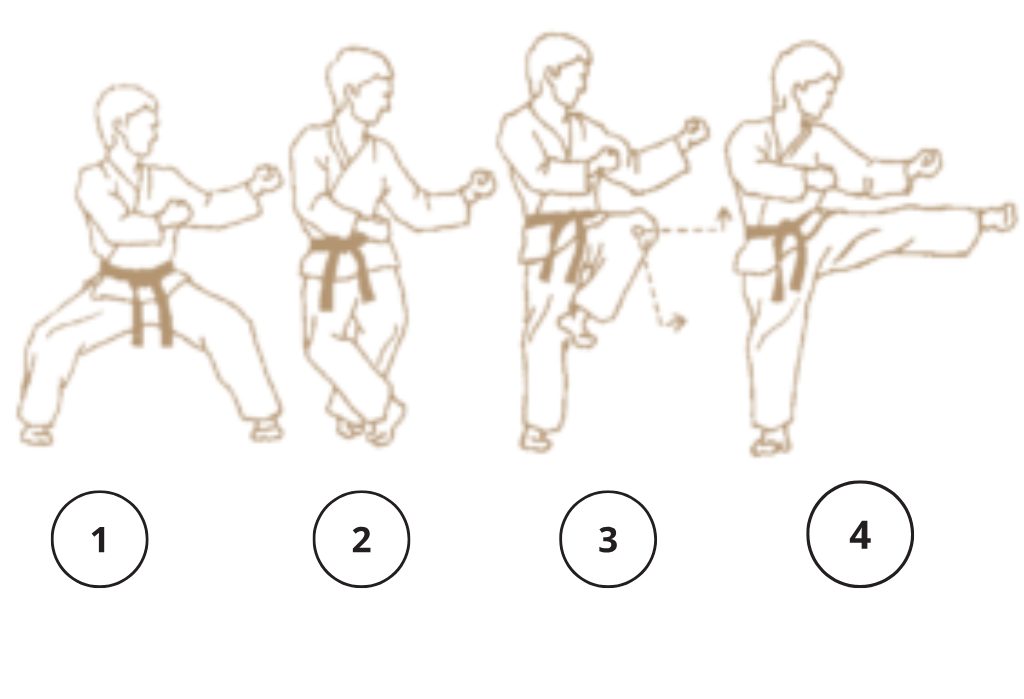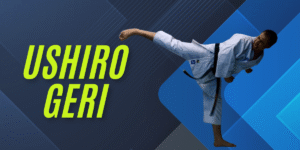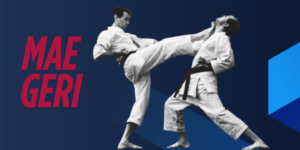Yoko Geri, or Sidekick, is a great weapon to have as a karateka.
Because of its simple mechanism, it is helpful in kumite and real fighting situations.
In this post, I will walk you through everything you need to know about the Yoko Geri, from its meaning to how to perform it correctly, and even its role in Kumite (competition).
What Does Yoko Geri Mean in Karate?
Yoko Geri, simply put, translates to “sidekick in Karate. “Yoko” means “side,” and “Geri” means “kick.”
The Yoko Geri is one of the most essential kicks in karate, and it is known for its ability to strike opponents with speed and power.
This kick is performed sideways, with the foot reaching out to the side rather than straight ahead.
It’s commonly used to attack the midsection or head of an opponent, depending on your stance and positioning.
Now, let’s have a look at the different variations of the Yoko Geri, as it’s not just a single kick but a family of related techniques!
Types of Yoko Geri Kicks

Yoko Geri Keage – Side Snap Kick
The “Keage” in its name refers to the snapping motion, where you extend your leg quickly and then snap it back.
It’s designed to be a fast, sharp strike that’s meant to disrupt your opponent’s balance.
When executing this kick, you aim for a fast, explosive motion.
The key here is in the snapping action of your foot—just like a whip, it should extend quickly and return just as fast.
It’s perfect for striking your opponent’s torso or head in a Kumite match, where you want to score a point while remaining light on your feet.
How to Perform Yoko Geri Keage:
- Start naturally, like Zenkutsu Dachi (front stance), with your hands ready for defense.
- Lift your knee towards your chest, keeping your foot relaxed.
- Quickly extend your foot sideways, snapping it out with your heel, aiming for the target.
- Immediately retract your foot to its starting position, keeping your balance intact.
Remember, the faster the snap, the more effective the kick
Yoko Geri Kekomi – Side Thrust Kick

Next up is the Yoko Geri Kekomi, or the Side Thrust Kick. Unlike the snap kick, this is about power and pushing through your opponent’s defense.
The “Kekomi” part refers to the thrusting motion, where you extend your leg fully and push with force to break through any block or guard.
This variation is used when you want to drive through an opponent’s defenses, typically aimed at the torso or the side of the head. The foot is usually flat when it strikes, making it a more solid, impactful kick than the snap kick.
How to Perform Yoko Geri Kekomi:
- From your starting stance, raise your knee to the side and pivot slightly on your standing foot.
- Extend your leg fully in a strong thrust, keeping your foot flat as you push outward toward the target.
- Hold the thrust for a moment before retracting the leg back to its starting position.
The key to the Kekomi is maintaining your body’s power throughout the entire movement.
Yoko Tobi Geri – Jumping Side Kick
And then, there’s the Yoko Tobi Geri or the Jumping Side Kick.
The “Tobi” part refers to the jump, so as you can imagine, this kick involves jumping into the air and delivering a sidekick while you’re mid-flight.
It’s not just for show—it’s a devastating attack when executed correctly.
This type of kick is used in Kata.
However, it can be helpful in Kumite competitions, where you need to close the distance quickly and land a powerful strike your opponent won’t expect.
For more information about Tobi Geri-Jumping kicks, click here.
How to Perform Yoko Tobi Geri:
- Begin by standing in a firm stance, keeping your hands up on guard.
- Jump upward, leading with your knee and pivoting your body as you lift off.
- As airborne, extend your leg to deliver the sidekick at the target.
- Land smoothly and regain your stance, ready for the next move.
The hardest part of this kick is timing the jump correctly.
You have to make sure you’re in the air long enough to land a solid kick while also ensuring you have the right balance when you land.
How to Perform Yoko Geri: A Step-by-Step Guide
Now that I have covered the different Yoko Geri kicks, let’s break down the basic Yoko Geri (side kick).
Whether you’re performing a Keage, Kekomi, or the basic Yoko Geri, the fundamental technique remains the same. Here’s a step-by-step guide to help you get it right.
Step 1: Start with the Right Stance
Before thinking about kicking, you need to start in a solid stance. This ensures you have the necessary balance and control for a clean kick.
The Zenkutsu Dachi (front stance) is often used for beginners, but you can adapt it depending on your comfort level and style.
- Feet placement: Keep your feet shoulder-width apart. If you’re in a front stance, your front foot should point straight ahead while your back foot is angled slightly out.
- Body posture: Keep your stance low. This helps with balance and ensures that you’re stable throughout the kick.
Step 2: Raise Your Knee and Pivot
The first motion of the Yoko Geri involves lifting your knee to the side. This prepares your leg to strike.
- Lift the knee: Bring your knee up towards your chest. You should aim to have your thigh parallel to the ground at this point.
- Pivot on your supporting foot: As you lift your knee, slightly pivot your standing foot outwards. This helps open up the hips and gives you more range of motion for the kick. Be sure to keep your body aligned and your balance centered.
Step 3: Extend the Kick
Now comes the actual kicking motion. This is where the power and precision of your kick come into play.
- Kick sideways: Extend your leg, aiming your foot toward your target. Whether you’re performing the snap kick (Keage) or thrust kick (Kekomi), the direction and motion remain sideways.
- Focus on your foot position: If you’re doing a Keage, your foot will be relaxed and flexible as it snaps out. For the Kekomi, your foot will be more rigid, like a thrust, with the heel pushing toward the target.
Step 4: Recoil and Reset
After your kick connects (or, in the case of practicing, when your foot reaches its target), you need to bring your leg back quickly. This helps you maintain balance and prepares you for the next move.
- Retract the leg: Once fully extended, the kick quickly brings your foot back to its original position as swiftly as you kicked it out. It is crucial for maintaining control and readiness for follow-up actions.
- Please return to your stance: Once your foot is back, return to your initial stance, whether it’s the front stance or another position you’re comfortable with.
Step 5: Common Mistakes to Avoid
Even though the Yoko Geri is a straightforward kick, a few common mistakes can make your technique less effective. Here’s what to watch out for:
- Not pivoting properly: If you don’t pivot your standing foot, you’ll lose range of motion, making your kick less powerful. Always make sure to turn that back foot out.
- Dropping your hands: A common mistake is forgetting to guard your face and body during the kick. Keep your hands up and protect yourself.
- Kicking too slowly: A sidekick needs to be fast and snappy. If you take too long to extend and retract your foot, you’ll lose the element of surprise and the kick’s power.
- Not engaging your core: Your core is the key to generating power. Your strike will lack force if you don’t engage it while kicking.
With practice, these steps will become second nature, and you can execute a clean, effective Yoko Geri every time.
Remember, don’t rush the process—take your time to perfect each step; soon enough, this kick will be a natural part of your Karate toolkit.
Is Yoko Geri Allowed in Kumite?
If you’ve ever been curious about how Yoko Geri fits into Kumite (Karate sparring), you’re in the right place!
Kumite is where Karate practitioners face off against each other in a controlled match, and knowing when and how to use your techniques is crucial.
The Yoko Geri—whether it’s the Keage (snap kick), Kekomi (thrust kick), or Tobi Geri (jumping side kick)—can all be used effectively in Kumite, but there are specific rules to follow.
Yoko Geri in Kumite: The Basics
In Kumite, Yoko Geri is a versatile tool for scoring points and disrupting your opponent’s balance.
However, like all Karate techniques, the Yoko Geri must be executed with precision and control.
There are strict guidelines about what is allowed in Kumite, and here’s what you need to know:
Types of Yoko Geri Allowed in Kumite
Yoko Geri Keage (Side Snap Kick)
- The snap kick is highly effective for striking the midsection or the head. In Kumite, it’s used when you want to quickly score a point, especially when your opponent is caught off guard.
- Legal Considerations: The kick must be controlled and not too forceful. Karate is about precision, not brute force. A controlled strike that lands cleanly on the opponent’s torso or head is legal.
Yoko Geri Kekomi (Side Thrust Kick)
- The powerful thrust kick is used to break through an opponent’s defenses. This can be effective in close-range Kumite when you want to push through and land a solid blow.
- Legal Considerations: Much like the Keage, the Kekomi should be delivered with control. It should not be performed with excessive force, as hitting too hard could lead to penalties.
Yoko Tobi Geri (Jumping Side Kick)
- The jumping sidekick is a dramatic, high-impact move that’s used to catch your opponent off guard.
- Legal Considerations: Because of its explosive nature, this kick is allowed in Kumite, but it must be executed with control.
Important Kumite Rules to Remember
- Control: In Kumite, the primary focus is on control. You can’t throw wild or uncalculated kicks. The referee will assess whether your kick is well-timed and controlled enough to score a point.
- Target Areas: Kicks to the head, body, and upper limbs are typically allowed, but strikes to the lower limbs or below the belt are often considered illegal. Always aim for the opponent’s torso or head.
- Point Scoring: A clean, controlled Yoko Geri that lands on your opponent’s body or head can score a point. No point will be awarded if the kick is too weak, uncontrolled, or lands in an illegal area.
How to Use Yoko Geri Effectively in Kumite
Here are a few tips on how to make the most of the Yoko Geri in Kumite:
- Timing is everything: The key to using the Yoko Geri effectively is to catch your opponent when they least expect it. Whether you’re throwing a Keage or a Kekomi, make sure your kick lands before they have time to react.
- Set up with feints: If you’re practicing Kumite, try using feints to distract or mislead your opponent. This will open them up to a well-timed Yoko Geri.
- Stay light on your feet: To execute any variation of Yoko Geri effectively, you must stay light and agile. Be ready to adjust your position immediately, and always know where your opponent is.
Final Thoughts
Mastering the Yoko Geri—the sidekick—is a game-changer for anyone training in Karate.
The ability to perform it correctly can make a huge difference in your performance, especially in Kumite, where timing and control are everything.
Now that you clearly understand how to perform the Yoko Geri and how it fits into Kumite, it’s time to get on the mat and start putting it into practice.
As with any Karate technique, the more you practice, the more effective and fluid your movements will become. So, get out there and master that sidekick!
FAQ
What is the difference between Yoko Geri Keage and Yoko Geri Kekomi?
Here’s a breakdown of the key differences:
- Yoko Geri Keage (Side Snap Kick): This kick is about speed. It’s a quick, sharp strike where the foot is snapped out to hit the target, usually with the heel.
- Yoko Geri Kekomi (Side Thrust Kick): The Kekomi, on the other hand, is a more powerful, thrusting motion. Instead of snapping the foot out, you push with your leg, generating more force as you strike.
In short, the Keage is a faster, lighter kick used for scoring quick points, while the Kekomi is a more powerful, thrusting kick that focuses on pushing through defenses.
Is Yoko Geri used in all Karate styles?
Yoko Geri is a fundamental technique used in almost all Karate styles, but its execution may vary depending on the style.
For example, in Shotokan Karate, the Yoko Geri is often performed with more emphasis on the thrusting motion, while in Goju-Ryu, the kick is more circular and flexible.
You Might Also Like










